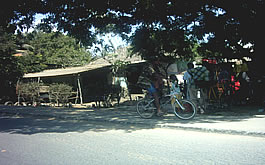|
Find your Trip
....................................................................................................................................
The Kenyan
Coastline
Watamu

The road from Mombasa to Watamu leads across the
Mtwapa bridge and past Mtwapa town, to the thriving sisal
plantations at Vipingo. Though it's being fixed, the road from
Mtwapa is full of potholes and requires extra care for cars with low
suspension.
Almost two hours from Mombasa is the sleepy town of
Watamu. Its atmosphere is that of a village, so stock up on supplies
before leaving Mombasa. Hotels are in plenty though, and our abode
is the Turtle Bay Beach Club, an all inclusive resort next to Kenya
's internationally acclaimed Watamu National Marine Park. The rooms
are cool and comfortable, fully air-conditioned with en-suite
bathrooms. Within the spacious lounges you may enjoy a beverage
anytime 24 hours a day. And outdoors are supervised pool games and
other beach activities. A vibrant kids club exists, so that parents
need not worry about their children at all.
Mida creek
Late afternoon when it's slightly cooler is the
time to take a drive to one of the most productive mangrove
ecosystems on earth- Mida creek, which forms part of the same
habitat as the Arabuko-Sokoke forest.
Visitors are very welcome to come and view this
habitat, accompanied by a knowledgeable guide. Saidi takes me on a
walk through the mangroves, of which there are 7 out of 9 types
present here. Small cupboards strategically placed around give some
more information. Mangrove barks and leaves actually neutralise the
salinity of salty sea water absorbed from underground, as they
require fresh water to grow. There are also uses for both their
leaves and barks, such as in dyeing clothes. Their flowers are used
by the local community to attract bees, so that the honey they make
is sold.
In Kiswahili mangroves are known as mkoko, and are a
habitat for many types of crabs, molluscs and mongoose.
But the most exciting bit is the walk along a suspended boardwalk
that crosses 260 metres through the mangrove forest. Only two people
at a time should be on any section, plus keep your balance
centralized. From up here there is a great view of the surrounding
mangrove canopy. I am told that the best time to take this walk is
when the tide is in, so that the swirling water below your feet
makes it all the more dramatic. But since the tide is currently out
we can take a closer look at the Mangrove roots. Different types
have different roots- some hang downwards, while others stick out of
the ground like sharp sticks. Here's an interesting survival tactic-
the seeds are naturally adapted with a long sharp protrusion at one
end, so that once it drops it immediately embeds itself into the
ground, like this one that has germinated.
At the end of the walk is a tree house or bird hide that offers
visitors a stunning view of Kirepwe island and Mida creek. The
forest and creek are linked by complex natural water flow systems
and the health of each habitat is dependent on the other. Saidi then
offers me a delicacy straight from the mangroves. He digs out
cylindrical white shapes from the roots, and to my surprise these
are actually oysters. Just pick the slimy insides and voila!- a
highly nutritious meal, especially good for the libido. That is if
you can stand how they look.
To avoid depleting these habitats the Arabuko-Sokoke Schools and
Exotourism Scheme (ASSETS) was set up. Through it, visitor's
entrance fees are equitably distributed throughout the communities
around the forest and creek so as to facilitate community projects
such as building clinics and schools, and to encourage the locals to
respect their environment.
The surprise of the day is certainly the sight of flamingoes
feeding in the shallows. They apparently fly here to re-fuel on the
variety of rich food items buried in the muddy sandflats at low
tide. Other birds include plovers, sacred ibis and little egrets.
Wear closed shoes when walking on the seabed as there are sharp
shells like this pinamuscatha, as well as sponges that house tiny
shrimps and fish.
So if this is your kind of pastime then make sure
to call in advance so as to find out if the tide is in, which as
said before, is the best time to take the boardwalk.
Entertainment
And to end the day, enjoy a theme night of good food and lots of
dancing back at your hotel. Not many discos are available in the
town, at least not the calibre of Malindi and Mombasa, so you'll
probably find yourself partying in the hotel enjoying the
all-inclusive offers till the sun comes up...
The air is alive as total strangers mingle and dance together
bonded by this thing that is universal no matter the language-
‘music'. And so ends our night by this beach that has been named the
fifth best, in the world…
|
Watamu facts:-
- Mida Creek has been designated an
Important Biodiversity Area.
- Arabuko-Sokoke Forest and Mida Creek
support some of Africa 's rarest wildlife.
- Is a key stop-over and non-breeding site
for migrating birds from Europe, Asia and the Middle East to
eastern and southern Africa .
|
Accommodation rates
and images
Related link: Malindi
Copyright 2007.
All rights reserved. Exotic Expeditions
Limited. | 


